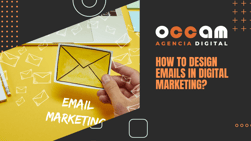Index Content
An email marketing strategy is a plan that uses email as a key to achieving business goals. It can include designing and creating emails, segmenting the contact list, sending emails and tracking results. Email marketing can be very effective in achieving business goals, but only if it is done correctly. In In Inbound Marketing, creating personalised and quality content for prospects is essential to generate, capture and nurture leads. By defining and implementing an email marketing strategy, the brand employs a series of digital tools. The combination of these tactics ensures an increase in open rates and sales.
The email marketing strategy opens a communication channel between the company and potential customers or clients. Email can be used to send promotional messages, newsletters, coupons and other valuable information. It is therefore a way to foster brand growth. However, there are some elements that must be taken into account when creating an effective email marketing strategy. For example, making sure that the contact list is up-to-date, relevant and the email is sent at the right time in the buyer's journey.
what is an email marketing strategy good for?
- Lower investment: Any company, regardless of its scope, can establish an email marketing strategy due to its low cost.
- Incorporate measurable campaigns: If an appropriate strategy is used, it can be measured and analysed to check its success and get the most out of it.
- Automate email sending: Digital marketing is constantly evolving and email marketing strategies allow you to incorporate automation tools into your marketing campaigns.
- Increase loyalty: One of the main objectives of the email marketing strategy is to improve the customer-company relationship. Developing a strategy that takes into account the user will lead to the sending of relevant content, personalised offers and recurrence. This will lead to increased cross-selling and up-selling.
- Personalise email: A good strategy ensures that emails can be personalised and include relevant content. The greater the personalisation, the higher the conversion rate.
- Obtain greater profitability: In the creation of an emailing strategy the investment is minimal. It works independently of seasonality or changes in the market. It is one of the communication channels with the highest ROI.
.jpg?width=400&height=214&name=estrategia%20para%20que%20sirve_page-0001%20(1).jpg) Key aspects of an effective email marketing strategy
Key aspects of an effective email marketing strategy
Selecting a software
To create an effective mailing strategy, it is advisable to use contact and email management software. These platforms can be used to organise customers in a database, perform follow-ups, understand which emails should be sent and automate actions. It is advisable to have an email service provider ( ESP) that offers a service for sending individual or bulk messages.
A software facilitates the daily work, unifies marketing actions in one place and applies techniques of an inbound strategy. HubSpot acts as a CRM for marketers and enables email marketing.
Understand your business's conversational strategy
An email marketing strategy is developed by understanding the internal aspects of your business, i.e. the conversational strategy your brand uses, whether you interact with customers through active listening, project the necessary information or build a long-term customer-company relationship.
Define business objectives
Establishing the objectives of the marketing strategy serves to determine its subsequent effectiveness, i.e. analysing the results of the campaign after it has been launched determines its success. This allows you to optimise your processes to obtain the best results.
How to create an email marketing strategy in 8 steps
1. Determine objectives
To start developing an email marketing strategy you need to know the current state of your company and its marketing campaigns. Analysing the results of the present is essential to know where you want to go. You should ask yourself some of the following questions:
- what marketing actions are working for my business?
- what do I want to achieve with an email marketing strategy?
- what processes should appear in my strategy?
2. Find out who is your target
Defining your brand's target audience will help ensure the personalisation of emails. The goal is to gather information from existing customers by focusing on their tastes, interests or behaviour with the website. Creating a buyer persona profile will help you to draw lines of action with real users.
3. Choose the type of mailings you will send
After knowing the objectives to be achieved and defining your target audience, you must choose the type of emails that will serve your business. Depending on the desired marketing action and user interaction with the website, these will vary. There are newsletters, automated emails, lead nurturing or welcome emails, among others.
4. Invest in software
To increase the success of your email marketing strategy, it is advisable to invest in software that guarantees the management of the campaign by centralising efforts and managing user interactions. To do this, you should know what your company's budget is and what type of emails you intend to send. If your brand needs additional features, you should have a platform with a higher investment.
5. Create a contact list
Contact lists will help your marketing efforts run more smoothly. With a database, you can gather relevant information about each contact or company.
6. Segment contacts
Segmenting the previously configured contact list will serve to divide users into groups according to their behaviours, demographics, interests or other characteristics. Automation processes can be automated, saving work for digital marketers.
7. Design the email and its content
Specialised email software often offers customised templates for your emails. However, depending on your business objective, you can design them yourself including the key elements of your campaign. It is important that the email design takes into account:
- Responsive design: Adaptability of the email to any device to increase your open rate and user interaction.
- Unsubscribe link: Emails should always include a link that allows the user to unsubscribe from the website. They should feel free to decide if they want to continue to be part of your contact list.
- Button design: Buttons in the email should be eye-catching, so the position and size you select will be key to making an impact on users.
.jpg?width=400&height=355&name=contenido%20email_page-0001%20(1).jpg) The content of the email should also be pre-selected based on the interests of your contacts and the intent of the marketing campaign. Some key elements should be paid attention to:
The content of the email should also be pre-selected based on the interests of your contacts and the intent of the marketing campaign. Some key elements should be paid attention to:
- Include the recipient's real name: This action will personalise the email and increase lead conversion.
- CTAs: Including calls to action will define your business objective and invite the customer to take an action.
- Subject: The subject line should motivate the recipient to open the email and should be catchy and personalised.
- Body: The body should be brief and apply the main ideas of the email marketing campaign.
- Preview: Providing a small snippet of the body will increase the recipient's curiosity.
- Headline: The headline should include keywords and clearly explain what the email is about.
8. Analyse the results obtained
After defining the sending frequency for your audience and registering the participation of users with the campaign, it is time to measure the results. This monitoring, previously configured, will pay attention to some of the following elements:
- Bounce rate: Number of emails that did not reach your recipients' inbox due to an invalid address or temporary error.
- Click-through rate: Percentage of users who clicked on the links in the email. The content should follow a structure to capture the reader's attention:
- Open rate: Percentage of customers who opened the email sent.
- Reactivity rate: Rate of people who actually opened the email and clicked on the link.
- Unsubscribe rate: Percentage of users who unsubscribed from a newsletter.
- Report rate: Number of users who reported your email as spam.
These results are analysed with the intention of improving failed actions and optimising your performance for the future. A/B testing is also used to improve email marketing tactics.





